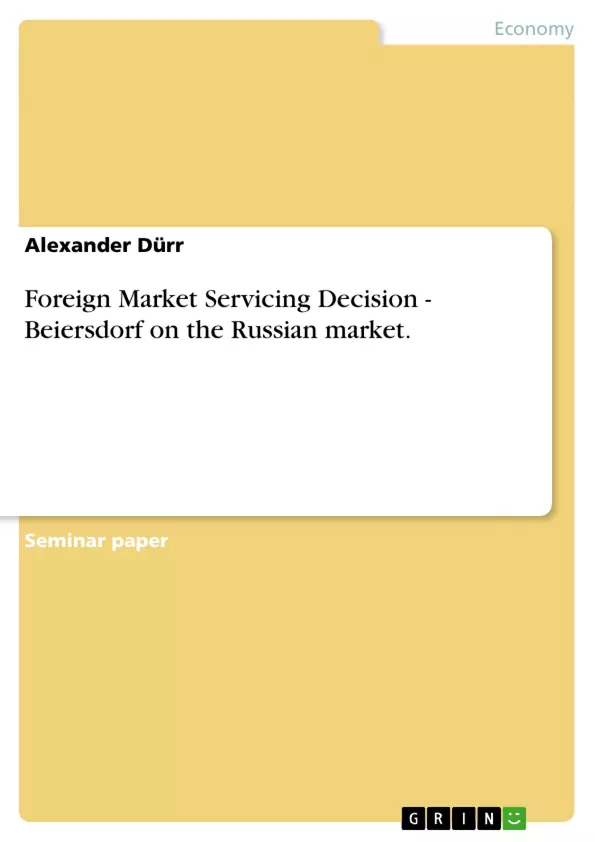As an example of international expansion this work will focus on the Beiersdorf AG and its intension to enter into the Russian market for cosmetic products. Although Beiersdorf is a Multi-National-Enterprise (MNE) with a high degree of experiences in foreign markets, they could be confronted with particular conditions as the Russian market is very specific.
The report is fundamentally structured in three main parts: First a short introduction about the Beiersdorf AG and their (cosmetic) products will be given. The second part is a detailed analysis of its environment and starts with assessing the firms strength ands weaknesses. Afterwards possible opportunities and threats for Beiersdorf in Russia will be analysed with regard to the competitive and external environment. The last section will focus on a Foreign Market Servicing Strategy (F.M.S.) for the market entry of Beiersdorf developed on the data of the analysis including the pros and cons of the suggested strategy.
Inhaltsverzeichnis (Table of Contents)
- Introduction (Aims and Objectives)
- Beiersdorf Group (Overview)
- Analyse of the environment (S.W.O.T.-Analyse)
- The internal environment of the firm
- The external environment
- The competitive environment of the industry
- The external environment of the country (P.E.S.T-Analyse)
- Modes of Entry (F.M.S.)
- Exporting
- Joint Ventures
- Foreign Direct Investment (FDI)
- Licensing
- The entry mode for the Russian market
Zielsetzung und Themenschwerpunkte (Objectives and Key Themes)
This coursework aims to examine the decision-making process involved in Beiersdorf AG’s expansion into the Russian market for cosmetic products. The report will analyze the company’s strengths, weaknesses, opportunities, and threats in relation to the Russian market. It will also delve into various foreign market servicing strategies and their applicability to Beiersdorf’s entry into Russia. Finally, the report will propose a suitable strategy for Beiersdorf to enter the Russian market based on the analysis conducted.
- Analyzing Beiersdorf’s internal and external environments
- Evaluating different foreign market servicing strategies
- Identifying the most suitable entry mode for Beiersdorf in Russia
- Assessing the strengths and weaknesses of Beiersdorf in the Russian market
- Examining the competitive landscape and external environment in Russia
Zusammenfassung der Kapitel (Chapter Summaries)
- Introduction: Introduces the focus of the work on Beiersdorf AG’s entry into the Russian market for cosmetic products, highlighting the importance of understanding the market’s unique characteristics.
- Beiersdorf: Provides an overview of Beiersdorf AG, its history, global presence, key brands, and its focus on the cosmed business line. This section emphasizes Beiersdorf’s international marketing strategy and its reliance on local strength.
- Analysis of the Environment: Discusses the importance of analyzing internal and external factors for successful market entry. It introduces the SWOT analysis framework, highlighting the need to assess strengths, weaknesses, opportunities, and threats.
- The internal environment of the firm: Explores Beiersdorf’s internal environment by analyzing its financial performance, investments, and strategic decisions. The section highlights the importance of the cosmed division to Beiersdorf and discusses recent strategic initiatives, such as the share buyback program.
- The external environment: This section delves into the external factors influencing Beiersdorf’s entry into the Russian market. It examines both the competitive environment within the industry and the broader external environment, using the PEST analysis framework.
Schlüsselwörter (Keywords)
The main keywords and focus topics of this work include Beiersdorf AG, foreign market servicing strategies, entry modes, SWOT analysis, PEST analysis, international expansion, competitive environment, Russian market, cosmetic industry, Nivea, and branding. These keywords encapsulate the core themes and concepts explored within the report.
- Citation du texte
- Alexander Dürr (Auteur), 2004, Foreign Market Servicing Decision - Beiersdorf on the Russian market., Munich, GRIN Verlag, https://www.grin.com/document/32968



